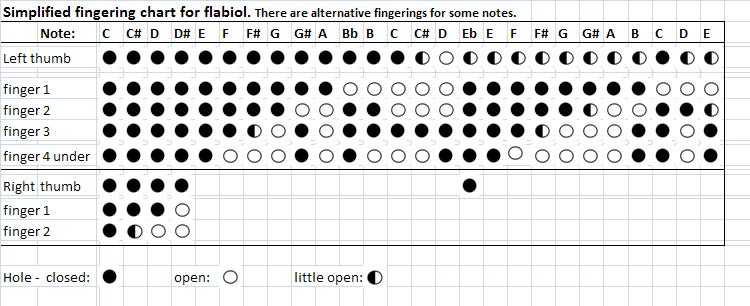Flabiol
|
Flabiol of bubinga wood | |
| Woodwind instrument | |
|---|---|
| Playing range | |
 |
The flabiol (Catalan pronunciation: [fɫəβiˈɔɫ]) is a Catalonian woodwind musical instrument of the family known as fipple flutes. It is one of the 12 instruments of the cobla. The flabiol measures about 25 centimeters in length and has five or six holes on its front face and three underneath.
Overview
The two main types are the dry flabiol without keys, usually made of a hardwood such as bubinga, and the keyed flabiol, used in coblas for sardana dances and in other folk music ensembles.
The flabiol is normally played by the left hand while the player uses the right hand to beat a small drum (called tamborí) attached to the left elbow.
All sardanes played by a cobla begin with a short introduction (introit) from the flabiol which is terminated by a single tap of the tamborí.
Its traditional geographic zone extends from the south of Catalonia to the Roussillon area of France, and from the Eastern strip of Aragon to the Balearic islands, where it is used as solo instrument with its own melodies.
Apart from being in the cobla for the performance of sardanes, the flabiol is also found in the reduced version of the cobla known as cobla of three quarters formed of one tarota or tible, a flabiol and a sac de gemecs (bagpipes).
Flabiol fingering
The flabiol is a transposing instrument in the key of F, and the played notes sound an eleventh (octave and a perfect fourth) higher than those written. The keyless Flabiol requires special playing skill, because it is generally played only with the left hand, using the thumb and the first 3 fingers. The little finger is placed under the instrument for "one-handed" stability. The 4 holes at the lower end are used as vent holes and tuning with wax plugs. If any of the four lowest semitones are required, the thumb and one or two fingers of the right hand have to be used. Keywork versions have the key pads between the top 3 toneholes for fast play. The Flabiol is the original model for the modern Tonette or Flutophone, popular with school children.

References
- Jeremy Montagu, Was the Tabor Pipe Always as We Know It?, in Early Music, Vol 9, No. 1. p 141
- Simon Broughton, Mark Ellingham, Richard Trillo, World Music: The Rough Guide, Vol 1, p 108
- Walter Aaron Clark, Isaac Albéniz: Portrait of a Romantic, Oxford University Press, 2002 p 197
See also
External links
- El testament n'Amèlia Video of a performance of this sardana (composer Joan Lamote de Grignon) by the cobla "Comptat d'Empúries" at the Castelló d'Empúries. The flabiol plays the theme tune as an extended introduction.
- MIDI files of folk pieces for flabiol collected by Joan Tomàs and Joan Amades [Catalan]